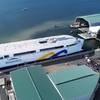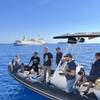To say the Gulf of Mexico maritime business had a down year would be a major understatement. But rags-to-riches-to-rags experience of the past has resulted in a consolidated, resourceful group of companies poised to pounce on the next market upturn … which should be very soon.
The business trends of consolidation and globalization that have largely defined the late 1990s have touched every level of business in the U.S., including the Gulf of Mexico maritime industry. Companies that had largely depended on "business as usual" are generally out of business today. The result: a resilient industrial base that is poised to prosper in good times and bad.
"Business is bad right now, as the oilfield is our primary source of business," said Ralston P. Cole, vice president Gulf Coast Region, Stewart & Stevenson. Cole — who's marine industry career now spans more than three decades and countless market mood swings — noted that the company has diversified its business, including selling engines and equipment to new emerging markets such as Paraguay and Argentina, but that ultimately, the company's good years will coincide with the health of local boat, ship and rig builders. While he notes that South American business is currently only about 10 percent, it is significant because its is out of sync with the flow of the offshore rig market.
Despite newfound efficiencies and markets, as Cole notes, the region is still largely ruled by the price per barrel of oil. While the nearly two year oil price swoon has been reversed for much of 1999, rising from around $10 per barrel in March to nearly $25 per barrel in September, the general mood of area businesses is still cautious, as confidence is generally based on firm orders in hand rather than slick market projections.
This caution has proven to be prudent.
While the stock market — the global business measuring stick — has generally been positive on the offshore oilfield sector throughout much of the year, there has been a relapse of sorts in October, as uncertainty surrounding OPEC output quotas has largely dampened the year's progress. In fact, a major tracker of offshore industry stocks, Warburg Dillon Read, in mid-October cut its ratings of four oilfield equipment and services companies. Among individual factors, Warburg cited expectations of flat oil rig demand everywhere except the Gulf of Mexico.
Global Marine Inc. was cut to "hold" from "buy," based on delays in the construction of two new drillships, the CR Luigs and Jack Ryan, and the resulting rising costs, Global's high 71 percent debt-to-equity ratio and the probability of negative cash flow in 2000 produced the downgrade; R&B Falcon Corp. cut to "hold" from "buy," due to the company's share price, the 2000 outlook for jackup and deepwater rig demand in Brazil, the North Sea, West Africa and the Gulf of Mexico and R&B Falcon's leveraged balance sheet; Transocean Offshore Inc. was cut to "hold" from "buy" with a 12-month price target of $32 a share after its proposed merger with Sedco Forex, with the expectation the deal will close by the end of the year; and Diamond Offshore Drilling Corp. was cut to "hold" from "buy," with a 12-month price target of $35.
Advancing the boatbuilding business
Impressions of the Gulf of Mexico vessel building businesses range from "mom-n-pop shop" to efficient, technically advanced shops. While there are still plenty of the former, the more accurate description today would have to be the latter, as there has been a significant amount of investment in the physical facilities and processes needed to build vessels of all sizes and configurations competitively on the international market. Litton Ship Systems is the largest and perhaps best-recognized ship builder in the area, if for no other reason than the high recognition of its diverse defense-orientated parent, Litton. The company now includes both Avondale Industries and Ingalls Shipbuilding under the company banner, and is poised under the leadership of Jerry St. Pe. The company's navy newbuilding reputation is without equal, and Litton, with the recent acquisition of Avondale Industries, has expanded its capabilities significantly to aid its future naval and commercial prospects. "I'm excited about the opportunities. The Avondale merger allows for the pursuit of programs that one yard alone could not," said Richard Schenk, vice president of business development.
Aside from the company's work for the navy — which is 90 percent of Ingalls Shipbuilding's businees and includes unparalleled success in building the Navy's advanced Aegis Destroyers, as well as preparing to commence production of the new DD21 class, as well as a host of other navy combatant and support vessels — its yards are currently building two of the more high-profile commercial projects — the AMCV cruise ships at Ingalls and the ARCO tankers at Litton Avondale — in the U.S. today. The AMCV project is significant on many counts, and has garnered generous coverage in these pages. But to recap, the cruise ships will be the largest ever built in the U.S. and represent the first cruise ship construction in more than 40 years. To say that all eyes are on Pascagoula is a gross understatement, as supporters and pundits alike watch the ships develop. In New Orleans, the first of the technically advanced Millennium class tankers is nearing completion for ARCO. The ships, which offer redundant systems throughout, are considered to be one of the more technologically advanced tanker projects in the world.
Ingalls Shipbuilding was able to make significant in-roads during the last offshore vessel and rig building boom, and is well positioned to weather the market downturn while being prepared for the fast ramp up. It's work in this area included eight months of outfitting and final prep work on the 100,000 ton Discoverer Enterprise. Work included lifting the 2,250 ton substructure drill floor onto the drilling ship, and conducting test and trial to ensure the ship was "drill ready" for Amoco.
According to Mike Williams, director of Ingalls’ Offshore Programs Business Development, Ingalls is well positioned to handle not only the technical demands but also the various cycles of the offshore market. Since most of Ingalls revenue is generated on the naval vessel side, the shipyard has an enviable continuity of workforce and technical expertise. Also, the company’s accessibility to the Gulf — just 11 miles from the deepwater GOM with no air draft restrictions — gives the yard the capability to handle the largest projects.
Whereas Ingalls gets the majority of its business from the government, Atlantic Marine Holding Co.’s two yards in Mobile — Alabama Shipyard (new construction) and Atlantic Marine - Mobile (repair and conversion — are wholly dependent on the commercial market for their success. E.C. “Buddy” McCormick, president of Atlantic Marine - Mobile, attributes this commercial-only vision as a major plank in ensuring his customer’s satisfaction, as it allows the ship repair and conversion professionals maximum flexibility in deploying the company’s vast resources. “Our customers don’t like to come into a shipyard,” they’d rather their ships be operating and making money. “So our focus is on turnaround time...we get them in and get them out."
While he admits that it might have been easy to be seduced by government work in the face of recent down offshore and marine markets, he staunchly believes — in part from traveling the globe and visiting repair and conversion colleagues — that government and commercial work don’t mix.
McCormick says Atlantic Marine-Mobile is a take-charge shipyard, and while the company is not always the low bidder, it always provides the best value.
The company’s president lists people, facilities and culture as the top reasons Atlantic Marine-Mobile has enjoyed great success since taking over the old World War II facility in 1989, and his assessment is more accurate than trite upon visiting the facilities.
Alabama Shipyard, the newbuild facility of Atlantic Marine Holding in Mobile, is currently involved in building the first of what it hopes is many OPA ‘90-compliant ATB barges. The unit — which was designed by the shipyard in a variety of sizes for a variety of purposes — is a 460 ft. (140 m), 135,000 barrel capacity notched barge for Reinauer Transportation, scheduled to enter service in December 1999. The unit will mate with a new 124-ft. (37.8 m) tug, Nicole Leigh Reinauer, which is being built at the Atlantic Marine Jacksonville facility.
Bollinger Shipyard, in Lockport, La., has been steadily expanding and increasing its capabilities, seemingly making giant strides forward in non-ideal business conditions. The company has just finished implementing an advanced software solution system which effectively has tied all divisions together in an information sharing arrangement that will create new levels of efficiency and quality management. The company is unique in that it runs a healthy share of commercial and military business through its facilities, as Scott Theriot, Executive Vice President of new construction, estimates that 35 percent of the company’s newbuilding business is military related. (Overall, the company has a fairly even 50/50 repair/new construction split.) While he admits that the process of becoming a good military and commercial yard entails a lot of trial and error, Theriot said.
A significant military contract has been for the construction of the Cyclone class patrol coastal ship. Bollinger recently launched USS Tornado. While it was the 14th of the Cyclone Class built by Bollinger, under a sole-source contract with the Navy, the vessel is the first to include design modifications, equipment and armament upgrades as part of the Navy's Pre-Planned Product Improvement Program.
Boasting a new, fully integrated bridge command and control system to increase the vessel's capabilities, Tornado is equipped with a satellite navigation system, forward looking infrared and surface radar with collision avoidance capabilities.
The vessel is based on the Vosper Thornycroft Ramadan class design and modified to meet Navy requirements. One specific change is the extension of the stern, which includes a ramp for the launch and recovery, while underway, of naval special warfare boats. As a result of this process, Tornado increased in length to 179 ft.(54.5 m) from the 170 ft. (51.8 m) earlier models.
As a further validation of its prowess on the military side of the business, Bollinger at press time announced the receipt of a $5.1 million contract to modify three Patrol Coast Ships (PC) for the U.S. Navy. The company has an option on a fourth vessel, which are of the Cyclone Class, which would bring the contract value to more than $6.7 million.
On the commercial side, Bollinger is nearly complete with a unique project in the building of the 105-ft. (32 m) Vera Bisso, for E.N. Bisso & Son, Inc. The vessel (which was featured in the October 1999 edition of Maritime Reporter, p. 40), is built for dual applications, as it can serve as a ship assist vessel along the Mississippi river, but is also capable of performing offshore work.
A new dawning
Horizon Shipbuilding in Bayou La Batre, Ala. and Travis E. Short, its president and CEO, have roots in the GOM maritime market dating back to Hudson Shipbuilding, which operated up until the first oil bust in the the early 1980s, and Owen Short Marine, which split apart two years ago.
Horizon Shipbuilding — which has signed a contract for the construction of a 135 x 32 ft. (41.1 x 9.7 m) dinner cruise vessel for an unnamed client. Scheduled for a March 2000 delivery, construction of the vessel commenced at Horizon's Bayou LaBatre, Ala. facility. Designed by A.K. Suda Naval Architects and Marine Engineers, the vessel will be certified to U.S. Coast Guard Subchapter K regulations for vessels under 100-gt.
Twin Caterpillar 3408 diesel marine turbocharged engines will power the vessel with electrical power provided by two 105 kW and one 170 kW CAT powered generators.
The company was also recently awarded a contract to construct a series of 30 ft. (9 m) fiberglass Improved Surface Tow Targets (ISTT) for the U.S. Naval Air Warfare Center, Weapons Division in Point Mugu, Calif.
According to Short, the total contract calls for the delivery of more than 30 units throughout the next two years.
Sponsored Content
Experience Custom Yacht Signs and Designs Tailored to Perfection!

April 2025
 Read the Magazine
Read the Magazine

 Read the Magazine
Read the Magazine
This issue sponsored by:

Applying and Measuring Deterrence – to Maritime Security and More
Subscribe for
Maritime Reporter E-News
Maritime Reporter E-News is the maritime industry's largest circulation and most authoritative ENews Service, delivered to your Email five times per week







